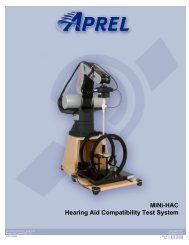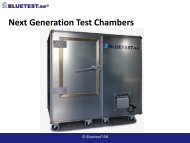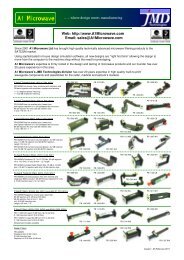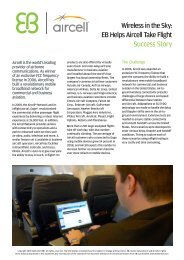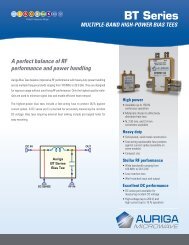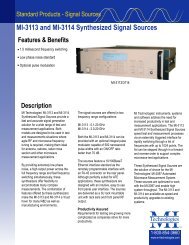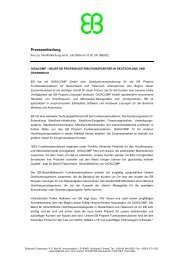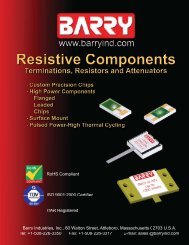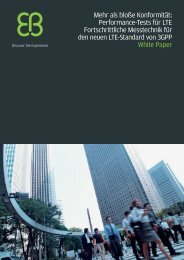EB Propsim Product Overview_ Aerospace, Fefense ... - Gigacomp
EB Propsim Product Overview_ Aerospace, Fefense ... - Gigacomp
EB Propsim Product Overview_ Aerospace, Fefense ... - Gigacomp
You also want an ePaper? Increase the reach of your titles
YUMPU automatically turns print PDFs into web optimized ePapers that Google loves.
<strong>Product</strong> overview:<br />
<strong>Aerospace</strong>, Defense and Military<br />
The wireless products can be field tested in a test setup that<br />
matches the intended use scenario. This could include for<br />
example performing drive testing with a measurement device<br />
through a coverage area of a radio network or measurements<br />
on different operational areas of RF sensors. Field testing is<br />
an essential part of wireless product, wireless system and<br />
applications development.<br />
It is a known fact that field testing is generally a laborintensive,<br />
time-consuming and expensive process - and<br />
sometimes even impossible to perform in advance with<br />
wireless equipment operating in some locations. When<br />
performing testing in the field, the testing of different<br />
environments requires physically moving the testing<br />
equipment to another geographical location. Field testing<br />
results are specific to the environment, location and time.<br />
They are non-repeatable, even under the exact same test<br />
setup, location and test scenario conditions. This is due to<br />
the fact that with field testing there is no real control over the<br />
natural environment or the radio channel effects.<br />
The benefit of radio channel emulation is that it enables<br />
accurate, controllable and fully repeatable test runs to be<br />
performed in a laboratory environment. Testing through radio<br />
channel emulation can be used to complement – or in some<br />
cases even replace – traditional field testing. Emulator testing<br />
significantly reduces the testing time and cost for a variety of<br />
standard and specific radio environments. With a radio<br />
channel emulator it is possible to test product performance<br />
during one test session in any environment such as indoor,<br />
metropolitan, highway, rural or mountainous areas. Faster<br />
testing cycles lead to shorter development cycles with<br />
reduced costs and with the excellent performance, maturity<br />
and reliability of the wireless product, systems and<br />
applications.<br />
The <strong>EB</strong> <strong>Propsim</strong> radio channel emulators provide unique<br />
emulation capabilities from HF to Microwave frequencies<br />
enabling users to implement and run the test scenarios in<br />
realistic environments under laboratory conditions with the<br />
highest accuracy and repeatability available.<br />
A more sophisticated approach to testing wireless products<br />
compared to field tests is to emulate the radio channel in a<br />
controlled laboratory environment. With this approach the<br />
radio channel is replaced with a radio channel emulator,<br />
which takes all the radio channel phenomena into account.<br />
The radio channel emulator is a test and measurement<br />
device connected between the transmitter and the receiver.<br />
The transmission passes through the emulator, which<br />
recreates e.g. path loss, shadowing, multipath fading, delay<br />
spread, Doppler spread, angle spread and polarization<br />
effects as well as provides the option for the addition of noise<br />
and interference. Figure 1 illustrates the principle of radio<br />
channel emulation testing.<br />
Receiver performance and application testing<br />
Figure 2 shows the received signal amplitude as a function of<br />
time in an urban environment. The total signal can be divided<br />
and categorized into a path loss component, shadowing<br />
effects (corner effects or toggling between Line Of Sight and<br />
Non-Line Of Sight states between transmitter and receiver)<br />
and fast fading effects (sum of multipath signals between<br />
mobile transmitter and receiver).<br />
Figure 2. Example of multipath signal received in mobile radio<br />
Base station<br />
<strong>EB</strong> <strong>Propsim</strong> F8<br />
Mobile terminal<br />
receiver in a typical urban environment.<br />
Figure 1. Typical test setup with a stand-alone radio channel<br />
emulator and transceivers under testing<br />
All <strong>EB</strong> <strong>Propsim</strong> products are covered with patents and patent applications.<br />
www.elektrobit.com/ebpropsim<br />
2 (5)



